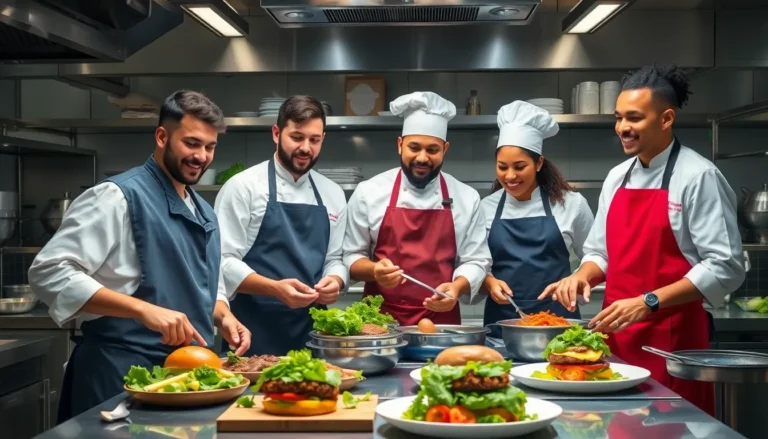Table of Contents
ToggleAs 2019 unfolds, food lovers everywhere are in for a treat. This year promises to shake up dinner plates and snack time in ways that’ll make taste buds tingle and Instagram feeds pop. From quirky flavor combinations to sustainable eating habits, the culinary world is buzzing with trends that are as delicious as they are exciting.
Overview of Food Trends 2019
Food enthusiasts embraced bold flavors in 2019. Quirky pairings captured attention, shifting culinary boundaries. Ingredients such as matcha, activated charcoal, and edible flowers flourished in dishes. Companies focused on plant-based options, reflecting a growing demand for sustainable choices.
Health-conscious diners increasingly sought out nutritious alternatives. Gluten-free and dairy-free products featured prominently in menus. Innovative preparations like cauliflower rice and zoodles gained popularity among health advocates.
Visual appeal played a major role in dining experiences. Restaurants crafted colorful presentations that enhanced social media shareability. Plating techniques elevated ordinary meals into artistic displays, encouraging food photography.
Environmental awareness influenced consumer preferences significantly. Many diners chose eateries championing eco-friendly practices. Sustainable sourcing of ingredients became a priority for numerous culinary establishments.
Global flavors also made an impact, with spices and sauces from various cultures enriching dining experiences. Unique items like hot sauces from international cuisines entered mainstream markets. Whether through tacos or ramen, fusion concepts thrilled adventurous eaters.
2019 marked a year of culinary exploration and innovation. Chefs pushed the envelope, inviting patrons to experience new tastes and textures. Food lovers found exciting opportunities to engage with their meals in fresh ways.
Healthy Eating Revolution

In 2019, a shift towards healthier eating gained significant momentum across dining scenes. Consumers increasingly gravitated towards options that emphasized nutrition and sustainability.
Plant-Based Diets
Plant-based diets surged in popularity, introducing a variety of delicious and nutritious meals. Many diners embraced dishes featuring legumes, whole grains, nuts, and seeds. The rise of meat alternatives, such as Beyond Meat and Impossible Foods, made plant-based eating accessible and appealing. Chefs incorporated innovative ingredients like jackfruit and tempeh to enhance flavor and texture. Even traditional cuisines showcased greater plant-based offerings. This trend not only catered to vegetarians and vegans but also attracted flexitarians seeking healthier, more sustainable options.
Keto and Low-Carb Options
Keto and low-carb options captured the attention of health-conscious diners. These meals featured high protein and fats, minimizing carbohydrates for effective weight management. Restaurants introduced creative dishes like zucchini noodles, cauliflower rice, and avocado-based desserts. Many consumers opted for snacks rich in protein over sugary treats. This trend fostered a diverse range of keto-focused eateries, expanding choices for those following low-carb lifestyles. As a result, supermarkets stocked more keto-friendly products, fulfilling the growing demand for convenient and satisfying alternatives.
Global Flavors Rise
Global flavors captured diners’ imaginations in 2019. Cuisine from various regions gained traction, transforming menus across restaurants.
Ethnic Cuisine Popularity
Ethnic cuisine gained remarkable popularity, enticing diners with authentic dishes. Bold spices and traditional cooking methods resonated with consumers. Ingredients from Thai, Indian, and Mexican kitchens found their way into everyday meals, elevating culinary experiences. Diners appreciated the rich flavors and varied textures these cuisines offered. Food lovers actively sought restaurants featuring authentic ethnic dishes, leading to a surge in demand for diverse options.
Fusion Foods
Fusion foods experienced a surge in interest, showcasing creative blends of culinary traditions. Unique combinations, such as Korean tacos and sushi burritos, became trendy. Chefs experimented with ingredients, pushing boundaries to create innovative dishes. Diners enjoyed the versatility of fusion concepts, allowing exploration of diverse flavors in one meal. Popularity of fusion foods reflected a desire for novelty and excitement in dining experiences, appealing to adventurous palates.
Sustainable Practices
Sustainable practices gained momentum in 2019, reflecting a significant shift in consumer preferences. Many diners now prioritize environmental impact, leading restaurants to adopt eco-friendly initiatives.
Locally Sourced Ingredients
Local sourcing emerged as a key trend, connecting diners to their communities. Chefs embraced fresh produce from nearby farms, enhancing ingredient quality and flavor. Seasonal menus flourished, creating a stronger bond between consumers and local agriculture. This practice reduced transportation emissions, supporting sustainable practices in the food industry. Furthermore, the emphasis on regional specialties showcased diverse culinary traditions, enriching the dining experience.
Reduction of Food Waste
Minimizing food waste received considerable attention, with restaurants implementing strategies to utilize every part of their ingredients. Chefs created inventive dishes from vegetable scraps and imperfect produce, transforming potential waste into gourmet meals. Various establishments initiated composting programs, diverting organic waste from landfills. This approach not only promoted sustainability but also educated diners on responsible consumption. Campaigns encouraging take-home leftovers gained traction, reassuring guests that every meal can have value.
Technology in Food
Technology revolutionized the food industry in 2019, enhancing dining experiences through innovative solutions.
Meal Delivery Services
Meal delivery services gained significant popularity last year. Customers relied on platforms like DoorDash and Uber Eats for convenient access to a wide variety of cuisines. Many restaurants partnered with these services to reach a broader audience. The success of subscription meal kits also surged, allowing home cooks to explore new recipes effortlessly. Companies like Blue Apron and HelloFresh made meal preparation accessible and enjoyable, catering to health-conscious consumers who aimed for balanced diets without excessive effort.
Smart Kitchen Gadgets
Smart kitchen gadgets showcased advanced culinary technology in 2019. Devices like air fryers and Instant Pots transformed home cooking by providing efficient, time-saving solutions. These multifunctional appliances enabled users to experiment with different cooking methods while maintaining flavor and nutrition. Additionally, smart thermometers and kitchen scales increased precision, helping home chefs achieve restaurant-quality results. The integration of apps into kitchen gadgets allowed seamless recipe browsing and ingredient tracking, enhancing user experience and cooking success.
The food trends of 2019 showcased a remarkable evolution in culinary experiences. With a focus on sustainability and visual appeal diners enjoyed innovative flavor combinations that delighted the senses. The rise of plant-based diets and global flavors offered something for everyone from health-conscious eaters to adventurous foodies.
Technology played a pivotal role in enhancing convenience and creativity in the kitchen making it easier for consumers to explore new cuisines and cooking methods. As the year unfolded it became clear that the culinary landscape is ever-changing driven by a desire for novelty and a commitment to environmental responsibility.
These trends not only shaped dining experiences but also encouraged a deeper connection between food and community. As we move forward the lessons learned in 2019 will undoubtedly influence future culinary innovations.







